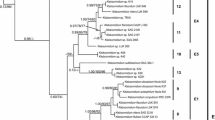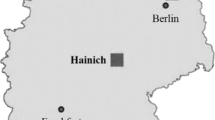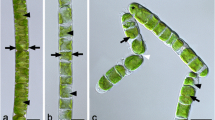Abstract
Stichococcus, a genus of green algae, distributes in ice-free areas throughout Antarctica. To understand adaptive strategies of Stichococcus to permanently cold environments, the physiological responses to temperature of two psychrotolerants, S. bacillaris NJ-10 and S. minutus NJ-17, isolated from rock surfaces in Antarctica were compared with that of one temperate S. bacillaris FACHB753. Two Antarctic Stichococcus strains grew at temperature from 4 to 25°C, while the temperate strain could grow above 30°C but could not survive at 4°C. The photosynthetic activity of FACHB753 at lower than 10°C was less than that of Antarctic algae. Nitrate reductase in NJ-10 and NJ-17 had its optimal temperature at 20°C, in comparison, the maximal activity of nitrate reductase in FACHB753 was found at 25°C. When cultured at 4–15°C a large portion of unsaturated fatty acids in the two Antarctic species was detected and the regulation of the degree of unsaturation of fatty acids by temperature was observed only above 15°C, though the content of the major unsaturated fatty acid αC18:3 in FACHB753 decreased with the temperatures elevated from 10 to 25°C. Elevated nitrate reductase activity and photosynthetic rates at low temperatures together with the high proportion of unsaturated fatty acids contribute to the ability of the Antarctic Stichococcus to thrive.





Similar content being viewed by others
References
Broady PA (1996) Diversity, distribution and dispersal of Antarctic terrestrial algae. Biodivers Conserv 5:1307–1335
Coles JF, Jones RC (2000) Effect of temperature on photosynthesis-light response and growth of four phytoplankton species isolated from a tidal freshwater river. J Phycol 36:7–16
Di Martino Rigano V, Vona V, Lobosco O, Carillo P, Lunn JE, Carfagna S, Esposito S, Caiazzo M, Rigano C (2006) Temperature dependence of nitrate reductase in the psychrophilic unicellular alga Koliella antarctica and the mesophilic alga Chlorella sorokiniana. Plant Cell Environ 29:1400–1409
Ding Y, Miao JL, Wang QF, Zheng Z, Li GY, Jian JC, Wu ZH (2007) Purification and characterization of a psychrophilic glutathione reductase from Antarctic ice microalgae Chlamydomonas sp. Strain ICE-L. Polar Biol 31:23–30
Ettl H, Gärtner G (1995) Syllabus der Boden-, Luft-, und Flechtenalgen. Gustav Fischer Verlag, Stuttgart
Feller G, Gerday C (1997) Psychrophilic enzymes: molecular basis of cold adaptation. Cell Mol Life Sci 53:830–841
Handa S, Nakahara M, Tsubota H, Deguchi H, Nakano T (2003) A new aerial alga, Stichococcus ampulliformis sp. nov. (Trebouxiophyceae, Chlorophyta) from Japan. Phycol Res 51:203–210
Hu H, Li H, Xu X (2008) Alternative cold response modes in Chlorella (Chlorophyta, Trebouxiophyceae) from Antarctica. Phycologia 47:28–34
Hughes KA (2006) Solar UV-B radiation, associated with ozone depletion, inhibits the Antarctic terrestrial microalga, Stichococcus bacillaris. Polar Biol 29:327–336
Li H, Liu X, Wang Y, Hu H, Xu X (2009) Enhanced expression of antifreeze protein genes drives the development of freeze tolerance in an Antarctica isolate of Chlorella. Prog Nat Sci 19:1059–1062
Lu Y, Chi X, Yang Q, Li Z, Liu S, Gan Q, Qin S (2009) Molecular cloning and stress-dependent expression of a gene encoding Δ12-fatty acid desaturase in the Antarctic microalga Chlorella vulgaris NJ-7. Extremophiles 13:875–884
Massalski A, Mroziiiska T, Olech M (2001) Ultrastructural observations on five pioneer soil algae from ice denuded areas (King George Island, West Antarctica). Polar Biosci 14:61–70
McKnight DM, Howes BL, Taylor CD, Goehringer DD (2000) Phytoplankton dynamics in a stably stratified Antarctic lake during winter darkness. J Phycol 36:852–861
Morgan-Kiss RM, Priscu JC, Pocock T, Gudynaite-Savitch L, Huner NPA (2006) Adaptation and acclimation of photosynthetic microorganisms to permanently cold environment. Microbiol Mol Biol Rev 70:222–252
Morgan-Kiss RM, Ivanov AG, Modla S, Czymmek K, Hüner NPA, Priscu JC, Lisle JT, Hanson TE (2008) Identity and physiology of a new psychrophilic eukaryotic green alga, Chlorella sp., strain BI, isolated from a transitory pond near Bratina Island, Antarctica. Extremophiles 12:701–711
Nagashima H, Matsumoto GI, Ohtani S, Momose H (1995) Temperature acclimation and the fatty acid composition of an Antarctic green alga Chlorella. Proc NIPR Symp Polar Biol 8:194–199
Neustupa J, Eliáš M, Šejnohová L (2007) A taxonomic study of two Stichococcus species (Trebouxiophyceae, Chlorophyta) with a starch-enveloped pyrenoid. Nova Hedwigia 84:51–63
Olivieri G, Marzocchella A, Andreozzi R, Pinto G, Pollio A (2011) Biodiesel production from Stichococcus strains at laboratory scale. J Chem Technol Biotechnol 86:776–783
Pollio A, Aliotta G, Pinto G, Paternò M, Bevilacqua A (1997) Ecophysiological characters and biochemical composition of Stichococcus bacillaris Naegeli strains from low pH environments. Algol Stud/Arch Hydrobiol 84:129–143
Priddle J, Hawes I, Ellis-Evans JC (1986) Antarctic aquatic ecosystems as habitats for phytoplankton. Biol Rev 61:199–238
Seaburg KG, Parker BC, Wharton RA, Simmons GM (1981) Temperature–growth responses of algal isolates from Antarctic oases. J Phycol 17:353–360
Stanier RY, Kunisawa R, Mandel M, Cohen-Bazire G (1971) Purification and properties of unicellular blue-green algae (Order Chroococcales). Bacteriol Rev 35:171–205
Stibal M, Elster J (2005) Growth and morphology variation as a response to changing environmental factors in two Arctic species of Raphidonema (Trebouxiophyceae) from snow and soil. Polar Biol 28:558–567
Swofford DL (1998) PAUP* 4.0—phylogenetic analysis using parsimony (*and other methods). Sinauer Associates, Sunderland
Teoh ML, Chu WL, Marchant H, Phang SM (2004) Influence of culture temperature on the growth, biochemical composition and fatty acid profiles of six Antarctic microalgae. J Appl Phycol 16:421–430
Thompson PA, Guo M, Harrisonp J, Whyte JNC (1992) Effects of variation in temperature. II. On the fatty acid composition of eight species of marine phytoplankton. J Phycol 28:488–497
Vinocur A, Izaguirre I (1994) Freshwater algae (excluding Cyanophyceae) from nine lakes and pools of Hope Bay, Antarctic Peninsula. Antarct Sci 6:483–489
Vona V, Di Martino Rigano V, Lobosco O, Carfagna S, Esposito S, Rigano C (2004) Temperature responses of growth, photosynthesis, respiration and NADH: nitrate reductase in cryophilic and mesophilic algae. New Phytol 163:325–331
Wiencke C, Dieck I (1990) Temperature requirements for growth and survival of macroalgae from Antarctica and southern Chile. Mar Ecol Progr Ser 59:157–170
Acknowledgments
This research was supported by the National Key Basic Research Project of China (2011CB200901) and National Natural Science Foundation of China (No. 40606004).
Author information
Authors and Affiliations
Corresponding author
Additional information
Communicated by S. Albers.
Rights and permissions
About this article
Cite this article
Chen, Z., He, C. & Hu, H. Temperature responses of growth, photosynthesis, fatty acid and nitrate reductase in Antarctic and temperate Stichococcus . Extremophiles 16, 127–133 (2012). https://doi.org/10.1007/s00792-011-0412-1
Received:
Accepted:
Published:
Issue Date:
DOI: https://doi.org/10.1007/s00792-011-0412-1




